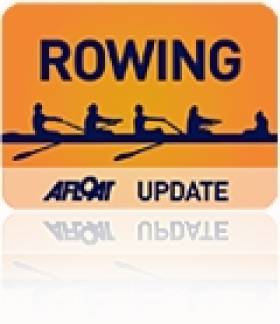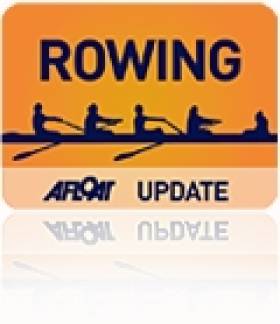Displaying items by tag: Trinity regatta
#Rowing: Trinity won the women’s senior eight at Trinity Regatta. The host crew were commanding winners over a Commercial eight made up of UCD alumni. In the semi-final they had beaten a Commercial eight made up of Trinity alumni.
Blue Star, the alumni club of Newcastle University, won the men’s intermediate eight. UCD were unable to finish after a race which featured a number of clashes and a restart. Blue Star featured British Olympians George Nash and Scott Durant (both gold medallists in 2016) as well as Irish Olympian Cormac Folan.
Trinity Regatta, Islandbridge, Saturday (Selected Results)
Men
Eight – Senior: Trinity bt Commercial 1 1/3 l. Club: Commercial bt Neptune A 1 ¾ l. Novice: UCD A; Trinity disuqual.
Four – Sen, coxed: Commercial B.
Sculling,
Quadruple – Jun 18: Neptune bt Three Castles 4l. Jun 18B, coxed: Blackrock. Jun 16: Graiguenamanagh. Masters, coxed: Commercial.
Single – Sen: Commercial (N Beggan) bt Carlow (L Keating) 1l. Inter: Sligo (G Patterson). Club One: Bann A (Christie). Junior: Carlow (J Keating) bt Neptune (J Butler) easily. Jun 16: Neptune (T Orlic). Masters: Thames (C George).
Women
Eight – Senior: Trinity bt Commercial, 2l. Inter: Trinity B bt Trinity A ¼ l. Club One: Commercial bt Neptune 2l. Nov: UCD A. Jun 18: Bann bt Graiguenamanagh, easily. Jun 16B: Graiguenamanagh. Masters: Tribesmen A.
Four – Inter: Trinity A. Masters, coxed: Belfast BC/Tribesmen.
Sculling,
Quadruple, Club One, coxed: Neptune. Nov, coxed: Trinity r/0. Jun 18B, coxed: Graiguenamanagh bt Neptune 1 ½ l.
Double – Senior: Neptune bt Njord easily.
Single – Inter: Neptune (Feerick). Club One: Neptune (Clarke). Club Two: Neptune (Clarke). Jun 18A: Neptune (Clarke). Jun 16: City Of Derry (E Murphy).
Trinity Rowers on Top at Home Regatta
#Rowing: Trinity won the men’s senior eights’ title at Trinity Regatta with a convincing display this morning. Commercial disputed the lead in the early stages of the race, but Trinity moved clear and won by one and one-third lengths. Conditions for the contest were perfect, with bright warm sunshine and calm water.
Trinity’s women’s senior eight won their semi-final against Commercial A.
UCD's Senior Eight Impress in Final Flourish
#Rowing: UCD’s senior eight beat Trinity by two and a quarter lengths at Trinity Regatta today. The very strong crew, stroked by David O’Malley, fashioned a lead after the second bend and held off the hosts. This may be the last time this crew rows together competitively as O’Malley, Shane Mulvaney and Shane O’Connell (who did now row at Trinity) will be called up for international duty.
In a cracking junior 18 eight final, Commercial just pipped neighbours and rivals Neptune. Garda’s Damien Kelly and Piers Ryan won the senior doubles race. Commercial, who won the women’s senior eight, also took the women’s junior 18 eight.
Trinity Regatta, Islandbridge (Selected Results)
Men
Eight – Senior: UCD bt Trinity, 2 ¼ l. Club: Trinity bt UCD did not finish. Inter: UCD bt Cork BC row over. Novice: Queen’s bt Trinity easily. Junior: Commercial bt Neptune half canvas. Masters: Neptune bt Commercial ½ l.
Four – Inter, coxed: UCD bt Cork row over. Club, coxed: Neptune bt UCD A disq. Masters, coxed: Neptune bt Graiguenamanagh easily. Junior, coxed: Commercial bt Neptune row over.
Pair – Senior: UCD bt KSRV Nord easily
Sculling,
Quadruple – Nov, coxed: Commercial bt Sligo easily. Jun 18B, coxed: Commercial bt Blackrock easily. Jun 16: Commercial bt Three Castles 2l.
Double – Senior: Garda bt Tralee/Shandon 3/4l
Single – Inter: Sligo (Patterson) bt Commercial (Casey) easily. Club One: Portadown (N Hull) bt Shannon (C Carmody) 2 ½ l. Jun 18: Neptune (J Butler) bt Commercial (K Brown) 4l. Jun 16: Three Castles (Keogh) bt Three Castles (Flynn) easily. Masters: Athlone bt Commercial 3l.
Women
Eight – Senior: Commercial bt Trinity 3 ½ l Club, coxed: Commercial bt Trinity 2l. Nov: Trinity A bt KSRV Njord 2l. Jun 18: Commercial bt Graiguenamanagh easily. Jun 16: Graiguenamanagh bt Athlone easily.
Four – Inter, coxed: Trinity B bt Trinity A 1l. Club, coxed: Commercial B t Commercial A 3l.
Sculling – Quadruple – Novice, coxed: Commercial bt UCD easily.
Double - Senior: Neptune bt KSRV Njord easily.
Single – Inter: Neptune (Feerick) bt Athlone (Curley) easily. Club: Neptune (A Clark) bt Garda (J Ryan) 3l. Nov: Commercial (Ballot) bt Graiguenamanagh (B Hennessy) 3l. Jun 16: Neptune (Clarke) bt Neptune (Daymon) 2l.
Commercial Women's Eight Beat Hosts at Trinity Regatta
#Rowing: Commercial beat Trinity in the women’s senior eights at Trinity Regatta today. Commercial were the more powerful crew and once they took the lead the held it to win by three and a half lengths. UCD’s senior men’s pair came out on top, while Jack Butler of Neptune was the top junior single sculler.
Trinity Regatta, Islandbridge (Selected Results)
Men
Eight – Club: Trinity bt UCD did not finish. Inter: UCD bt Cork BC row over. Masters: Neptune bt Commercial ½ l.
Four – Club, coxed: Neptune bt UCD A disq. Masters, coxed: Neptune bt Graiguenamanagh easily. Junior, coxed: Commercial bt Neptune row over.
Pair – Senior: UCD bt KSRV Nord easily
Sculling,
Quadruple – Nov, coxed: Commercial bt Sligo easily. Jun 18B, coxed: Commercial bt Blackrock easily. Jun 16: Commercial bt Three Castles 2l.
Single – Inter: Sligo (Patterson) bt Commercial (Casey) easily. Jun 18: Neptune (J Butler) bt Commercial (K Brown) 4l.
Women
Eight – Senior: Commercial bt Trinity 3 ½ l Club, coxed: Commercial bt Trinity 2l. Nov: Trinity A bt KSRV Njord 2l. Jun 16: Graiguenamanagh bt Athlone easily.
Four – Inter, coxed: Trinity B bt Trinity A 1l. Junior, coxed:
Sculling – Double - Senior: Neptune bt KSRV Njord easily.
Single – Inter: Neptune (Feerick) bt Athlone (Curley) easily. Club: Neptune (A Clark) bt Garda (J Ryan) 3l. Jun 16: Neptune (Clarke) bt Neptune (Daymon) 2l.
UCD Best Senior Eight at Trinity Regatta
#Rowing: UCD took away the biggest prize at Trinity Regatta today. They had a clear win over Commercial in the semi-final, by one and a quarter lengths, and beat the hosts’ eight in the final by three and a half lengths. Trinity’s women’s senior eight won their final, beating Dutch visitors KSRV Nord, who had come through the semi-final after UCD were disqualified.
Trinity Regatta, Islandbridge, Saturday (Selected Results)
Men
Eight – Senior: UCD bt Trinity 3½ l. Intermediate: UCD bt Commercial ¾ l. Club: UCD bt Commercial. Novice: Trinity A bt Trinity C 2l. Jun 18: Commercial bt Neptune 2l. Jun 16: Portora bt Commercial.
Four – Senior, coxed: UCD bt Trinity A. Intermediate, coxed: UCD bt Trinity B.
Pair – Senior: UCD bt Trinity A.
Sculling, Quadruple – Novice, coxed: Neptune bt King’s Hospital. Jun 18: Commercial bt Carlow 2½ l. Jun 18, coxed: Three Castles bt Commercial A. Jun 16, coxed: Commercial bt Portora 4l. Jun 15, coxed: Portora bt Blackrock A.
Double – Sen: Sligo bt Carlow 2l. Jun 15: Three Castles bt Bann A.
Single – Senior: Garda (D Kelly) bt Trinity (Van Gent). Inter: Garda (Allen) bt Carlow (Murphy). Club: Carlow (Nolan) bt Sligo (Patterson). Nov: Commercial (Jarvis) row over Queen’s (Foster). Jun 18: Graiguenamanagh (Lennon) bt (O’Brien). Jun 16: Carlow bt Carlow (Mead). Jun 15: Three Castles (Flynn) bt Three Castles (Keogh).
Women
Eight – Senior: Trinity bt KSRV Nord (Holland) easily. Inter: Commercial bt Trinity 5½ l. Club: UCD bt Commercial 2¼ l. Nov: UCD bt Trinity B 3l. Jun 16: Portora bt Carlow 4l. Jun 15: Carlow bt Portora A.
Four – Club, coxed: Trinity A bt Commercial B.
Sculling, Quadruple – Novice, coxed: Commercial B bt Neptune A . Jun 18: Carlow bt Commercial. Jun 18, coxed: Carlow bt Commercial 2½ l. Jun 16, coxed: Bann bt Commercial. Jun 15, coxed: Commercial bt Graiguenamanagh easily.
Double – Jun 15: Commercial bt Galway easily.
Single, Sen: Trinity (G Foley) bt Commercial (J Besse) 4l. Club One: Carlow (A Byrne) bt Commercial (O’Connor) 2l. Jun 18: Neptune (Feerick) bt Bann (Wylie). Jun 16: King’s Hospital (Wedgewood) bt Commercial (K Dolan)
Trinity Regatta Hit Hard by NUIG and UCD Withdrawals
#ROWING: The absence of the senior eights of UCD/Old Collegians and Gráinne Mhaol/NUIG – both entered, both did not compete – robbed Trinity Regatta of the anticipated top-level racing in this category today. Conditions were superb, with bright sunshine and calm water, and there were good wins for the Old Collegians senior pair of Peter Grogan and Gearóid Duane and Seán Jacob in the senior single sculls.
Trinity Regatta, Islandbridge, Saturday (Selected Results)
Men
Eight – Club: Commercial bt Neptune easily. Intermediate: UCD A bt Neptune 1¼ l. Novice: Trinity A bt UCD canvas. Junior 16: Reading Bluecoat A bt Portora 4½ l. Junior 15: Reading Bluecoat A bt Reading Bluecoat B easily.
Four – Senior, coxed: Trinity A bt Trinity B canvas. Club, coxed: Garda bt Blackrock ¾ l. Intermediate, coxed: UCD A bt Commercial 3l.
Pair – Senior: Old Collegians (G Duane, P Grogan) bt Commercial ¾ l.
Sculling
Quadruple – Junior 18B, coxed: Athlone bt Portadown 3l. Junior 16, coxed: Commercial bt Neptune A 6l. Junior 15, coxed: Reading Bluecoat bt Three Castles 3l.
Double – Junior 15: Carlow A bt Three Castles ½ l.
Single – Senior: Old Commercial (S Jacob) bt Trinity (Hurley) 2¾ l. Club: Garda (D Kelly) bt UCD (Toland) 1 ¼ l. Intermediate: UCD A (T Hughes) bt Garda (Kelly) 2l. Masters: Carlow bt Commercial easily. Junior 18: Neptune (Mulvaney). Junior 16: Graiguenamanagh (A Lennon) bt Commercial (Baskerville) 2½ l. Junior 15: Three Castles (O Clune).
Women
Eight – Club: Trinity bt Commercial ¾ l. Novice: UCD bt Trinity 3½ l. Junior 18: Commercial bt Portora ¾ l.
Four – Club, coxed: Commercial bt Trinity D 5l.
Sculling,
Quadruple – Junior 16, coxed: Portora A bt Commercial 2½ l
Single – Club: Commercial (A Rodger) bt Commercial (Edwards) 4½ l. Junior 18A: Commercial (E Lambe) bt Carlow (Byrne) 5l. Junior 16: Neptune (Deasy) bt Neptune (Ferrick) ¾ l.
Women's Eights Final Sparks Controversy at Trinity Regatta
# ROWING: UCD won 11 of the finals at Trinity regatta at Islandbridge in Dublin today, including the men’s senior eights, fours and single sculls – with Dave Neale in each of the winning crews. The big controversy of the day concerned the women’s senior eights, where a re-row was ordered after a clash early in the race. UCD decided not to compete – prompting anger from some Trinity mentors. Trinity won on a row over.
Trinity Regatta, Islandbridge, Dublin (Selected Results)
Men
Eight – Senior: UCD bt Trinity 5l. Novice: UCD A bt Trinity B 3½ l. Intermediate: UCD A bt UCD B 3l. Junior 18: Neptune bt Portora 2l. Junior 16: Portora A bt Portora B 2l. Masters: Old Collegians bt Shannon 3l.
Four – Senior, coxed: UCD A bt Trinity 3l. Intermediate, coxed: UCD A bt UCD B 1½ l. Novice, coxed: UCD A bt UCD B 1½ l. Junior 18, coxed: Portora bt Athlunkard ½ l.
Pair – Senior: UCD bt Commercial B 1l.
Sculling, Quadruple – Novice, coxed: Neptune A bt Trinity A 1¼ l. Junior 18: Neptune bt Athlone easily. Junior 16, coxed: Killorglin bt Commercial, disqualified.
Double – Intermediate: Carlow bt Garda A easily. Junior 16: Waterford bt Shannon 5l.
Single – Senior: UCD (D Neale) bt Carlow (A Bolger) 3l. Intermediate: Garda A bt Three Castles 3l. Junior 18: Shannon bt Commercial 3½ l. Junior 16: Athlone bt Waterford A 2 ½ l. Masters: Commercial A bt City of Derry 3l. Lightweight: Carlow B bt Trinity 2l.
Women
Eight – Senior: Trinity row over UCD. Intermediate: UCD bt Commercial 1¼ l. Novice: Trinity A bt UCD A disqualified. Junior 18, coxed: Portora bt Commercial, distance. Junior 16: Shannon A bt Portora easily.
Four – Senior, coxed: UCD A bt Trinity 5l. Intermediate coxed: UCD bt Commercial 2½ l. Novice, coxed: Commercial bt UCD A 1l. Junior 18, coxed: Portora A bt Portora B 3l.
Sculling
Quadruple – Novice, coxed: Carlow bt Commercial A easily. Junior 18: Carrick-on-Shannon bt Commercial easily. Junior 16, coxed: Killorglin bt Carrick-on-Shannon 3l. Double – Intermediate: Killorglin row over UCD.
Single – Senior: Trinity (Sinead Dolan) bt Trinity (S O’Brien) 1¼ l. Novice: Fermoy A bt Killorglin easily. Junior 18: Carrick-on-Shannon bt Fermoy 3l. Junior 16: Commercial (Lambe) bt Killorglin 4l. Masters: Carlow bt Neptune easily.
































































